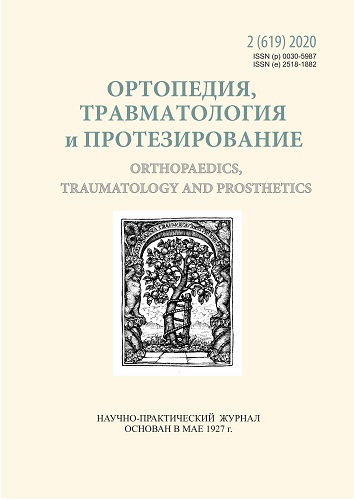The results of treatment of flexible pes planovalgus in children with cerebral palsy
DOI:
https://doi.org/10.15674/0030-59872020280-88Keywords:
cerebral palsy, flat-foot deformity of the feet, retrospective analysis of treatment methods and subtalar arthroereisisAbstract
The treatment of mobile flat-foot deformity in children with cerebral palsy remains unresolved due to a variety of structural, functional and biomechanical changes in the foot, as well as the complex pathogenesis of formation. Objective: to present a differentiated approach and analysis of the results of surgical treatment of mobile flat-foot deformity in children with cerebral palsy. Methods: the results of surgical treatment of mobile flatfoot deformity were analyzed in 39 patients with cerebral palsy, who were divided into three groups. The choice of intervention method depended on the child's age, level of motor functions and clinical characteristics of the deformity. Sape and function disorders of the foot were evaluated according to AOFAS hindfoot scale. The author’s working clinical and radiological classification of this deformity was also applied. Results: surgical treatment of mobile flat-foot deformity in patients with cerebral palsy aged 7–11 years using soft tissue surgery is accompanied by a significant percentage of reccurence deformations (66.7 %). Additional application of the technique of subtalar arthroereisis can improve clinical and radiological results, but 80 % is accompanied by the development of chronic pain syndrome. In patients with cerebral palsy, older than 12 years, the effectiveness of surgical treatment of moderate and severe mobile flat-foot deformity using corrective lateral elongating osteotomy of the calcaneus bone and corrective osteotomy of the medial sphenoid bone has been clinically confirmed. Conclusions: the developed algorithm for differentiated choice of surgical treatment for mobile flat-foot deformity in children with cerebral palsy, depending on age, level of motor functions and clinical characteristics of the deformity, allowed us to choose between minimally invasive methods (subtalar arthroereisis, soft tissue surgery) and surgical interventions on the bones and joints of the foot (corrective calcaneus osteotomy, arthrodesis of the joints of the posterior and middle parts of the foot).References
- Kadhim, M., Holmes, L., Church, C., Henley, J., & Miller, F. (2012). Pes planovalgus deformity surgical correction in ambulatory children with cerebral palsy. Journal of Children's Orthopaedics, 6(3), 217-227. doi: 10.1007/s11832-012-0413-3
- Miller, F. (2005). Etiology, epidemiology, pathology, and diagnosis. Cerebral palsy, New York: Springer
- Wen, J., Liu, H., Xiao, S., Li, X., Fang, K., Zeng, M., Tang, Z., Cao, S., & Li, F. (2017). Comparison of mid-term efficacy of spastic flatfoot in ambulant children with cerebral palsy by 2 different methods. Medicine, 96(22), e7044. doi: 10.1097/md.0000000000007044
- Davids, J. R. (2010). The foot and ankle in cerebral palsy. Orthopedic Clinics of North America, 41(4), 579-593. doi: 10.1016/j.ocl.2010.06.002
- Sees, J. P., & Miller, F. (2013). Overview of foot deformity management in children with cerebral palsy. Journal of Children's Orthopaedics, 7(5), 373-377. doi: 10.1007/s11832-013-0509-4
- Kadhim, M., & Miller, F. (2014). Crouch gait changes after planovalgus foot deformity correction in ambulatory children with cerebral palsy. Gait & Posture, 39(2), 793-798. doi: 10.1016/j.gaitpost.2013.10.020
- Mosca, V. S. (2010). Flexible flatfoot in children and adolescents. Journal of Children's Orthopaedics, 4(2), 107-121. doi: 10.1007/s11832-010-0239-9
- Kenis, V. M. (2014). Orthopedic treatment of foot deformities in children with cerebral palsy. Sankt-Peterburg. [in Russian]
- Korolkov, O. I., Rakhman, P. M., & Kikosh, G. V. (2017). Implant to stabilize the heel joint in the treatment of flat-valgus deformity stop. Ukraine. Patent 113131 UA. [in Ukrainian]
- Murley, G. S., Menz, H. B., & Landorf, K. B. (2009). A protocol for classifying normal- and flat-arched foot posture for research studies using clinical and radiographic measurements. Journal of Foot and Ankle Research, 2(1). doi: 10.1186/1757-1146-2-22
- Kirby, K. (1999). Biomechanics and the treatment of flexible flatfoot deformity in children. The Journal of the Pediatric Biomechanics, 7, 10-11
- Korolkov, A. I., Lutkevich, N. I., & Haschuk, A. V. (2013). Conceptual approaches to the diagnosis and prophylactic treatment of hip subluxation and dislocation in patients with cerebral palsy. Orthopedics, traumatology and prosthetics,3, 20-27. doi: 10.15674/0030-59872013320-27. [in Russian]
- Marks, V. O. (2001). Orthopedic diagnostics. Practical guide. Taganrog: Progress. [in Russian]
- Miller, M. D., Thompson, S. R., & Hart, J. (2012). Review of Orthopaedics. Elsevier Health Sciences
- De Boer, A. S., Tjioe, R. J., Van der Sijde, F., Meuffels, D. E., Den Hoed, P. T., Van der Vlies, C. H., Tuinebreijer, W. E., Verhofstad, M. H., & Van Lieshout, E. M. (2017). The American orthopaedic foot and ankle society ankle-hindfoot scale; translation and validation of the Dutch language version for ankle fractures. BMJ Open, 7(8), e017040. doi: 10.1136/bmjopen-2017-017040
Downloads
How to Cite
Issue
Section
License
Copyright (c) 2020 Oleksandr Korolkov, Pavіеl Rakhman

This work is licensed under a Creative Commons Attribution 4.0 International License.
The authors retain the right of authorship of their manuscript and pass the journal the right of the first publication of this article, which automatically become available from the date of publication under the terms of Creative Commons Attribution License, which allows others to freely distribute the published manuscript with mandatory linking to authors of the original research and the first publication of this one in this journal.
Authors have the right to enter into a separate supplemental agreement on the additional non-exclusive distribution of manuscript in the form in which it was published by the journal (i.e. to put work in electronic storage of an institution or publish as a part of the book) while maintaining the reference to the first publication of the manuscript in this journal.
The editorial policy of the journal allows authors and encourages manuscript accommodation online (i.e. in storage of an institution or on the personal websites) as before submission of the manuscript to the editorial office, and during its editorial processing because it contributes to productive scientific discussion and positively affects the efficiency and dynamics of the published manuscript citation (see The Effect of Open Access).














